From a Coal Mining Area to a Wetland Park: How Is the Social Landscape Performance in Pan’an Lake National Wetland Park?
Abstract
1. Introduction
2. Overview and History of the Pan’an Lake National Wetland Park
2.1. Overview of Study Area
2.2. Construction and Development of Pan’an Lake National Wetland Park
- (1)
- Land Reclamation and Remediation (2000–2008)
- (2)
- Ecological Restoration Planning and Construction (2009–2012)
- (3)
- Transformation and Comprehensive Development (2013–2021)
- (4)
- Efforts to Create a National 5A-Level Tourist Attraction (2022–Present)
3. Materials and Methodology
3.1. Establishment of the Social Landscape Performance Conceptual Framework
- (1)
- Indicators from Landscape Performance Series and Cultural Ecosystem Services
- (2)
- Characteristics of Coal Mining Subsidence Wetland Parks
- ➀
- Environmental quality improvement based on ecological restoration. The park’s ecological restoration not only improves the mining area’s environment but also promotes the physical and mental health of surrounding residents.
- ➁
- Characteristic industrial cultural landscape. Integrating industrial cultural elements that represent the city’s history into the landscape highlights the city’s historical significance for residents and supports urban transformation.
- ➂
- Regional synergistic development through ecological transition. Ecological restoration can drive synergistic development in surrounding areas, such as improving infrastructure, promoting industrial transformation, and enhancing the city’s image.
- ➃
- Special status of surrounding residents. Displaced farmers, as stakeholders in park construction, benefit from improved living environments but must also adapt to the transition from rural to urban lifestyles.
- (3)
- Referring to wetland park evaluation standards and regulations
3.2. Questionnaire Design and Distribution
- (1)
- Questionnaire design
- 1:
- Very Unimportant/Very Dissatisfied;
- 2:
- Unimportant/Dissatisfied;
- 3:
- Neutral;
- 4:
- Important/Satisfied;
- 5:
- Very Important/Very Satisfied.
- (2)
- Questionnaire distribution
3.3. Determination of Indicator Weight by Analytic Hierarchy Process (AHP)
3.4. Social Landscape Performance and Classification Using Fuzzy Comprehensive Evaluation (FCE)
- Set the social landscape performance of the PLNWP evaluation index, U. U = (Ui) (where i = 1, 2, 3, 4, 5 correspond to the five criteria levels: B1, B2, B3, B4, B5), with the secondary indicators composed of Uij.
- Construct the evaluation grade set, V. Each evaluation indicator is divided into five grades, namely V = {v1, v2, v3, v4, v5}, corresponding to “Very poor” (1 point), “Poor” (2 points), “Fair” (3 points), “Good” (4 points), and “Excellent” (5 points), as Table 2 showed.
- Determine the fuzzy comprehensive evaluation set, B. The weights of each evaluation indicator are determined using the analytic hierarchy process (AHP), and the formula for fuzzy comprehensive evaluation is defined as follows:
3.5. Importance–Performance Analysis (IPA)
4. Results
4.1. Reliability and Validity Analysis
4.2. Characteristics of the Respondents
- (1)
- Characteristics of tourists
- (2)
- Characteristics of local residents
4.3. Weights of Indicators
4.4. Fuzzy Comprehensive Evaluation of Social Landscape Performance of PLNWP
4.5. Mapping the IPA Plots: Local Residents and Tourists
4.5.1. From Local Residents’ Perspectives
- (1)
- Strengths Maintenance Zone
- (2)
- Steady Maintenance Zone
- (3)
- Gradual Refinement Zone
- (4)
- Key Improvement Zone
4.5.2. From Tourists’ Perspectives
- (1)
- Strengths Maintenance Zone
- (2)
- Steady Maintenance Zone
- (3)
- Gradual Refinement Zone
- (4)
- Key Improvement Zone
5. Discussion
5.1. Social Landscape Performance Assessment and Indicators
5.2. IPA: Different Perception from Local Residents and Tourists
5.3. Strategies for Enhancing Social Landscape Performance of Pan’an Lake National Wetland Park
5.3.1. Rational Planning of Zoning and Enrichment of Wetland Landscapes
5.3.2. Enhancing Accessibility and Improving Services and Infrastructure
5.3.3. Improving Science Popularization and Environmental Awareness
5.3.4. Creating a Diverse Landscape and Enhancing the Visibility of Public Art
5.4. Limitations and Future Directions
6. Conclusions
Author Contributions
Funding
Data Availability Statement
Acknowledgments
Conflicts of Interest
References
- Zhou, K. Wetland Landscape Pattern Evolution and Prediction in the Yellow River Delta. Appl. Water Sci. 2022, 12, 190. [Google Scholar] [CrossRef]
- Yang, Y.; Zhang, Y.; Su, X.; Hou, H.; Zhang, S. The Spatial Distribution and Expansion of Subsided Wetlands Induced by Underground Coal Mining in Eastern China. Environ. Earth Sci. 2021, 80, 112. [Google Scholar] [CrossRef]
- Deng, X.; Chen, G. Characteristics of Water Pollution and Evaluation of Water Quality in Subsidence Water Bodies in Huainan Coal Mining Areas, China. J. Chem. 2022, 2022, 2857700. [Google Scholar] [CrossRef]
- Chen, Y.; Hu, Z.; Li, P.; Li, G.; Yuan, D.; Guo, J. Assessment and Effect of Mining Subsidence on Farmland in Coal–Crop Overlapped Areas: A Case of Shandong Province, China. Agriculture 2022, 12, 1235. [Google Scholar] [CrossRef]
- Chen, L.; Zhang, H.; Zhang, X.; Liu, P.; Zhang, W.; Ma, X. Vegetation Changes in Coal Mining Areas: Naturally or Anthropogenically Driven? Catena 2022, 208, 105712. [Google Scholar] [CrossRef]
- Nakade, D.; Dhadse, S. Biodiversity loss due to mining activities. Sustain. Biodivers. Conserv. 2024, 3, 49–65. [Google Scholar] [CrossRef]
- Krzysztofik, R.; Dulias, R.; Kantor-Pietraga, I.; Spórna, T.; Dragan, W. Paths of Urban Planning in a Post-Mining Area. A Case Study of a Former Sandpit in Southern Poland. Land. Use Policy 2020, 99, 104801. [Google Scholar] [CrossRef]
- Feng, S.; Hou, W.; Chang, J. Changing Coal Mining Brownfields into Green Infrastructure Based on Ecological Potential Assessment in Xuzhou, Eastern China. Sustainability 2019, 11, 2252. [Google Scholar] [CrossRef]
- Wang, L.; Wang, L.; Yin, P.; Cui, H.; Liang, L.; Wang, Z. Value Assessment of Artificial Wetland Derived from Mining Subsided Lake: A Case Study of Jiuli Lake Wetland in Xuzhou. Sustainability 2017, 9, 1860. [Google Scholar] [CrossRef]
- Li, Z.; Chang, J.; Li, C.; Gu, S. Ecological Restoration and Protection of National Land Space in Coal Resource-Based Cities from the Perspective of Ecological Security Pattern: A Case Study in Huaibei City, China. Land 2023, 12, 442. [Google Scholar] [CrossRef]
- Zheng, X.; Wang, F. Construction of an Adaptive River-Based Recreational Network for Urban River Restoration: A Case Study of Rencheng District, Jining City, China. J. Clean. Prod. 2022, 374, 133985. [Google Scholar] [CrossRef]
- Abandoned Pit Area Transformed into Scenic Park in N China’s Hebei. Available online: https://english.www.gov.cn/news/202307/23/content_WS64bcbe9dc6d0868f4e8de0c5.html (accessed on 9 June 2025).
- Xie, P. Striving Towards Ecocity: Experience from Huainan, China. Available online: https://www.smartcitiesdive.com/ex/sustainablecitiescollective/striving-towards-ecocity-experience-huainan-china/190911/ (accessed on 9 June 2025).
- Muntoni, F.; Balvis, T.; Rizzo, R.; Loru, P. Territorial Planning of Geological Mining Historical and Environmental Park of Sardinia. Geoheritage 2020, 12, 22. [Google Scholar] [CrossRef]
- Streever, W.J. Kooragang Wetland Rehabilitation Project: Opportunities and Constraints in an Urban Wetland Rehabilitation Project. Urban. Ecosyst. 1998, 2, 205–218. [Google Scholar] [CrossRef]
- Hartter, J.; Southworth, J. Dwindling Resources and Fragmentation of Landscapes around Parks: Wetlands and Forest Patches around Kibale National Park, Uganda. Landsc. Ecol. 2009, 24, 643–656. [Google Scholar] [CrossRef]
- Zhao, J.; Huang, Y.; Tang, T.; Yang, S. Reclamation of Coal Mining Subsidence Based on People’s Esthetic Preference. Int. J. Environ. Sci. Technol. 2022, 19, 6243–6250. [Google Scholar] [CrossRef]
- Lupp, G.; Konold, W.; Bastian, O. Landscape Management and Landscape Changes towards More Naturalness and Wilderness: Effects on Scenic Qualities—The Case of the Müritz National Park in Germany. J. Nat. Conserv. 2013, 21, 10–21. [Google Scholar] [CrossRef]
- von Döhren, P.; Haase, D. Ecosystem Services for Planning Post-Mining Landscapes Using the DPSIR Framework. Land 2023, 12, 1077. [Google Scholar] [CrossRef]
- Kodir, A.; Hartono, D.M.; Haeruman, H.; Mansur, I. Integrated Post Mining Landscape for Sustainable Land Use: A Case Study in South Sumatera, Indonesia. Sustain. Environ. Res. 2017, 27, 203–213. [Google Scholar] [CrossRef]
- Hine, A. Disrupting Landscape: Enacting Zones of Socio-Material Entanglement for Alternative Futures. Extr. Ind. Soc. 2021, 8, 100889. [Google Scholar] [CrossRef]
- Svobodova, K.; Sklenicka, P.; Vojar, J. Dominance Level of Significant Features in Post-Mining Landscapes as a Predictor of Perceived Scenic Beauty. In Mine Planning and Equipment Selection; Drebenstedt, C., Singhal, R., Eds.; Springer International Publishing: Cham, Swizerland, 2014; pp. 843–853. [Google Scholar]
- Singh, S.K.; Kumar, D. Optimizing Coal Mine Planning and Design for Sustainable Development in the Context of Mass Exploitation of Coal Deposits. Heliyon 2024, 10, e28524. [Google Scholar] [CrossRef]
- Yang, B. Landscape Performance Evaluation in Socio-Ecological Practice: Current Status and Prospects. Socio-Ecol. Pract. Res. 2020, 2, 91–104. [Google Scholar] [CrossRef]
- Brown, R.D.; Corry, R.C. Evidence-Based Landscape Architecture: The Maturing of a Profession. Landsc. Urban. Plan. 2011, 100, 327–329. [Google Scholar] [CrossRef]
- Taner, R.O. Social value of urban landscapes: Performance study lessons from two iconic Texas Projects. Landsc. Archit. Front. 2016, 4, 12–29. [Google Scholar]
- Church, S.P. Exploring Green Streets and Rain Gardens as Instances of Small Scale Nature and Environmental Learning Tools. Landsc. Urban. Plan. 2015, 134, 229–240. [Google Scholar] [CrossRef]
- Yang, B. Landscape Performance: Ian McHarg’s Ecological Planning in the Woodlands, Texas; Routledge: London, UK, 2018; ISBN 978-1-315-63682-5. [Google Scholar]
- Veitch, J.; Ball, K.; Crawford, D.; Abbott, G.R.; Salmon, J. Park Improvements and Park Activity: A Natural Experiment. Am. J. Prev. Med. 2012, 42, 616–619. [Google Scholar] [CrossRef]
- Yang, B.; Pamela, B.; Chris, B. Residential landscape performance evaluation:A visual and bioclimatic analysis based on field data. Landsc. Archit. 2015, 1, 87–98. [Google Scholar]
- Yang, B.; Li, S. Blending Project Goals and Performance Goals in Ecological Planning: Ian McHarg’s Contributions to Landscape Performance Evaluation. Socio-Ecol. Pract. Res. 2019, 1, 209–225. [Google Scholar] [CrossRef]
- Krsnik, G.; Illán-Fernández, E.J. Assessing Indicators and Preferences of Cultural Ecosystem Services in Urban Areas: A Case Study of Murcia, Spain. Landsc. Ecol. 2024, 39, 190. [Google Scholar] [CrossRef]
- Dickinson, D.C.; Hobbs, R.J. Cultural Ecosystem Services: Characteristics, Challenges and Lessons for Urban Green Space Research. Ecosyst. Serv. 2017, 25, 179–194. [Google Scholar] [CrossRef]
- Wang, Z.; Yang, B.; Li, S.; Binder, C. Economic Benefits: Metrics and Methods for Landscape Performance Assessment. Sustainability 2016, 8, 424. [Google Scholar] [CrossRef]
- Wu, S.-J.; Ng, E.; Lin, K.-B.; Cheng, Y.-H.; LePage, B.A.; Fang, W.-T. Influence of Landscape Preference and Place Attachment on Responsible Environmental Behavior—A Study of Taipei’s Guandu Nature Park Wetlands, Taiwan. Land 2023, 12, 2036. [Google Scholar] [CrossRef]
- Chakraborty, S.; Avtar, R.; Raj, R.; Thu Minh, H.V. Village Level Provisioning Ecosystem Services and Their Values to Local Communities in the Peri-Urban Areas of Manila, The Philippines. Land 2019, 8, 177. [Google Scholar] [CrossRef]
- Saaty, T.L.; Peniwati, K.; Shang, J.S. The Analytic Hierarchy Process and Human Resource Allocation: Half the Story. Math. Comput. Model. 2007, 46, 1041–1053. [Google Scholar] [CrossRef]
- Faerber, L.S.; Hofmann, J.; Ahrholdt, D.; Schnittka, O. When Are Visitors Actually Satisfied at Visitor Attractions? What We Know from More than 30 Years of Research. Tour. Manag. 2021, 84, 104284. [Google Scholar] [CrossRef]
- Jin, C.; Li, L.; Wang, Q.; Shao, J. Application of Fuzzy Comprehensive Evaluation (FCE) Method in the Evaluation of Outdoor Sports Environment in Cold Region Universities: A Case Study of Harbin, China. In Proceedings of the 5th International Conference on Resources and Environmental Research—Icrer 2023; Yuan, C., Ed.; Springer Nature: Cham, Switzerland, 2024; pp. 117–131. [Google Scholar]
- Wang, W.; Dong, C.; Dong, W.; Yang, C.; Ju, T.; Huang, L.; Ren, Z. The Design and Implementation of Risk Assessment Model for Hazard Installations Based on AHP–FCE Method: A Case Study of Nansi Lake Basin. Ecol. Inform. 2016, 36, 162–171. [Google Scholar] [CrossRef]
- Martilla, J.A.; James, J.C. Importance-Performance Analysis. J. Mark. 1977, 41, 77–79. [Google Scholar] [CrossRef]
- Boley, B.B.; McGehee, N.G.; Tom Hammett, A.L. Importance-Performance Analysis (IPA) of Sustainable Tourism Initiatives: The Resident Perspective. Tour. Manag. 2017, 58, 66–77. [Google Scholar] [CrossRef]
- Suryawan, I.W.K.; Sianipar, I.M.J.; Lee, C.-H. Community Importance-Performance Preferences and Policy Adaptiveness in Marine Debris Management: A Case Study from the Komodo Subdistrict, Indonesia. Mar. Policy 2025, 174, 106592. [Google Scholar] [CrossRef]
- Xiao, X.; Ye, Q.; Dong, X. Using Importance–Performance Analysis to Reveal Priorities for Multifunctional Landscape Optimization in Urban Parks. Land 2024, 13, 564. [Google Scholar] [CrossRef]
- Xu, J.; Yin, P.; Hu, W.; Fu, L.; Zhao, H. Assessing the Ecological Regime and Spatial Spillover Effects of a Reclaimed Mining Subsided Lake: A Case Study of the Pan’an Lake Wetland in Xuzhou. PLoS ONE 2020, 15, e0238243. [Google Scholar] [CrossRef]
- Tan, X.; Peng, Y.; Liu, S.; Liu, P. Landscape Pattern and Ecotourism Carrying Capacity of Pan’an Lake Wetland Park in Xuzhou City, China. Desalination Water Treat. 2020, 188, 288–296. [Google Scholar] [CrossRef]
- Zhang, J.; Zhu, X.; Gao, M. The Relationship between Habitat Diversity and Tourists’ Visual Preference in Urban Wetland Park. Land 2022, 11, 2284. [Google Scholar] [CrossRef]
- Ridding, L.E.; Redhead, J.W.; Oliver, T.H.; Schmucki, R.; McGinlay, J.; Graves, A.R.; Morris, J.; Bradbury, R.B.; King, H.; Bullock, J.M. The Importance of Landscape Characteristics for the Delivery of Cultural Ecosystem Services. J. Environ. Manag. 2018, 206, 1145–1154. [Google Scholar] [CrossRef] [PubMed]
- Nicola, S.; Schmitz, S. From Mining to Tourism: Assessing the Destination’s Image, as Revealed by Travel-Oriented Social Networks. Tour. Hosp. 2024, 5, 395–415. [Google Scholar] [CrossRef]
- Conesa, H.M.; Schulin, R.; Nowack, B. Mining Landscape: A Cultural Tourist Opportunity or an Environmental Problem?: The Study Case of the Cartagena–La Unión Mining District (SE Spain). Ecol. Econ. 2008, 64, 690–700. [Google Scholar] [CrossRef]
- Tabak, B.; Trišić, I.; Štetić, S.; Nechita, F.; Ilić, M.; Obadović, M.; Dobrescu, A.I. Economic and Socio-Cultural Development Dimension—Two Lake-Protected Areas’ Sustainability: A Case of Hungary and Serbia. Land 2025, 14, 479. [Google Scholar] [CrossRef]
- Sánchez-Arredondo, L.H.; López-Gómez, A.; Garavito-Higuera, S.A. Exploration of Mining Heritage and Evaluation of Mining Tourism Potential in the La Ferrería Village, Mining Territory of the Municipality of Amagá, in the Northwestern Colombian Andes. Int. J. Geoheritage Parks 2025, 13, 274–289. [Google Scholar] [CrossRef]


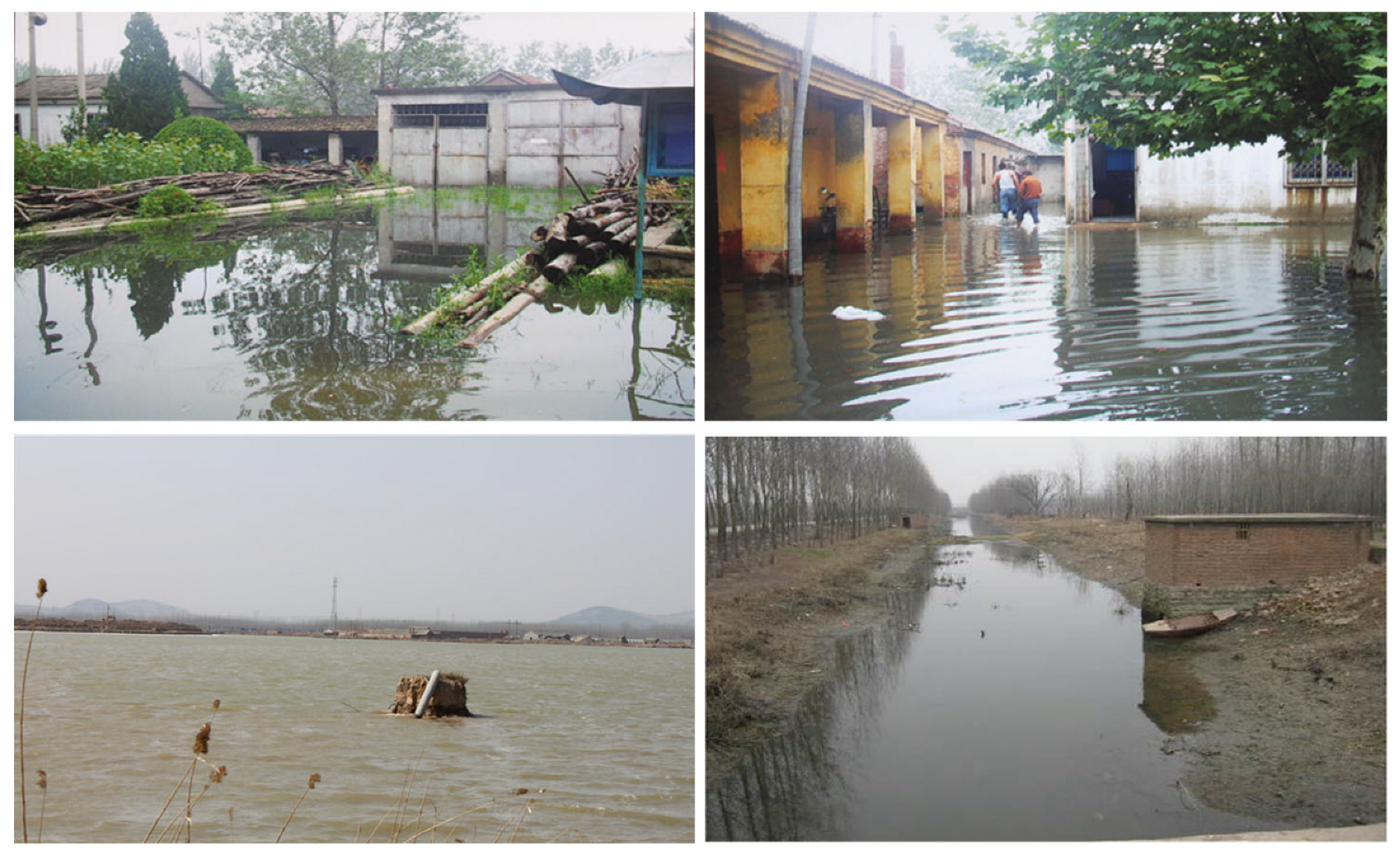
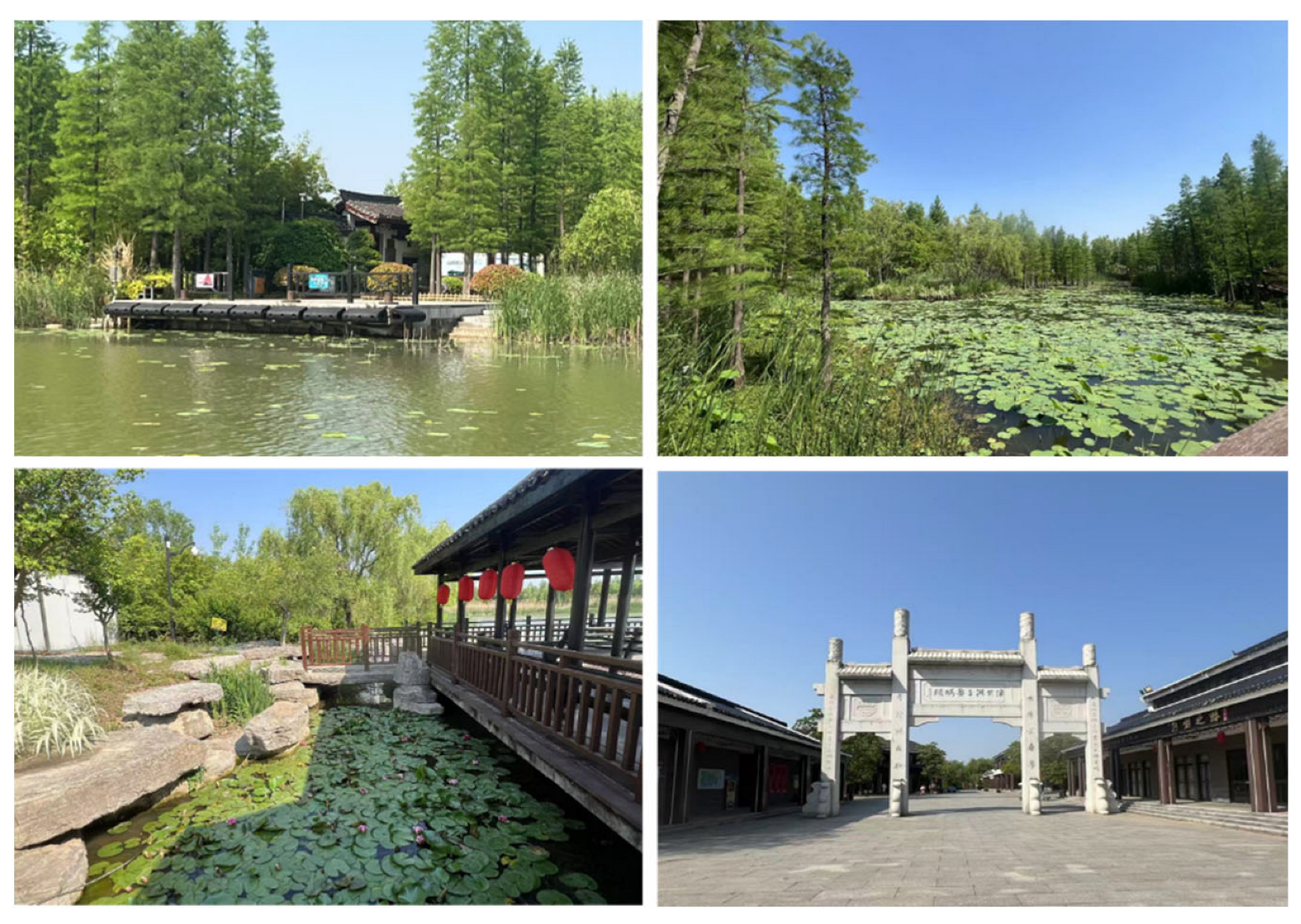
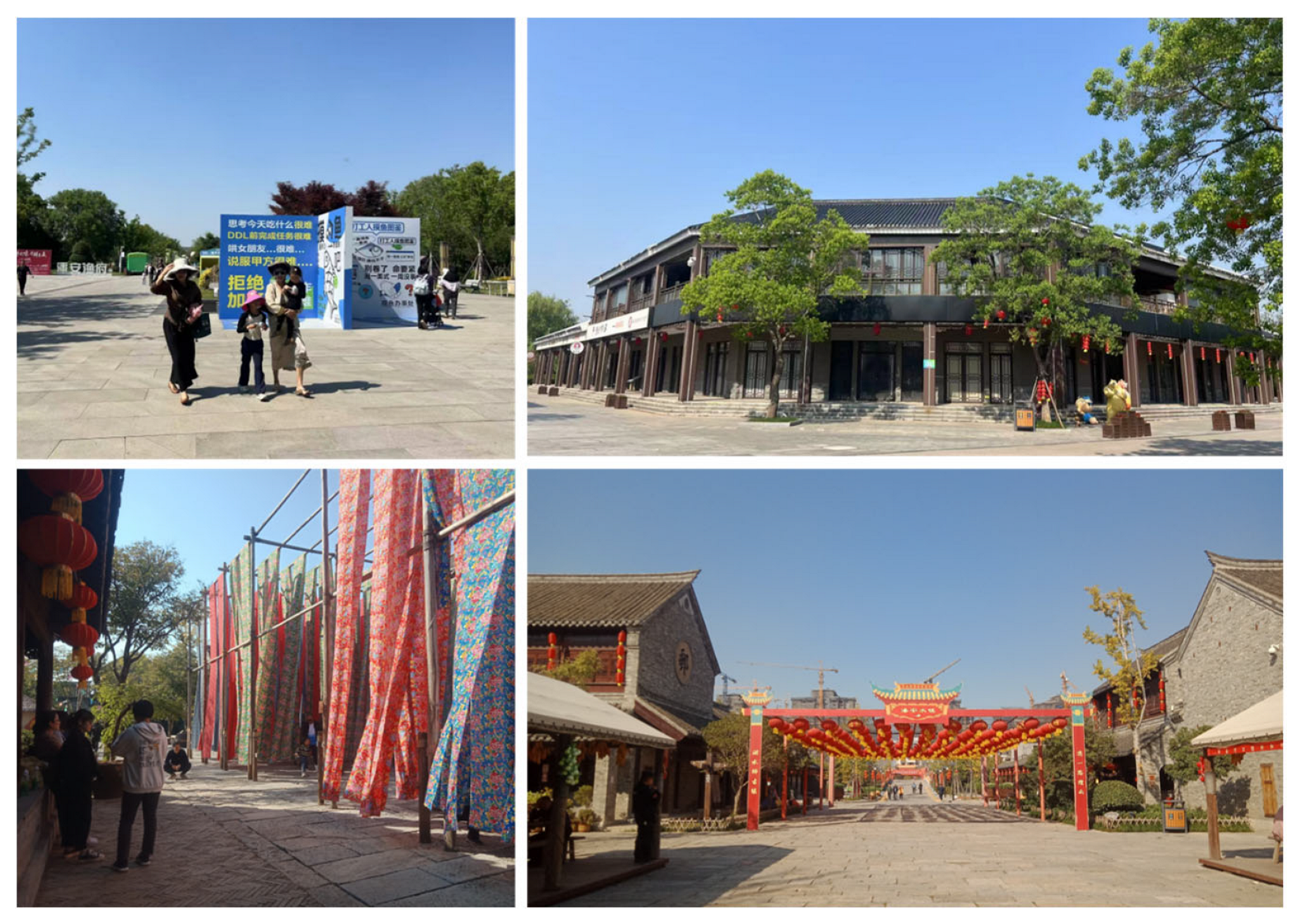

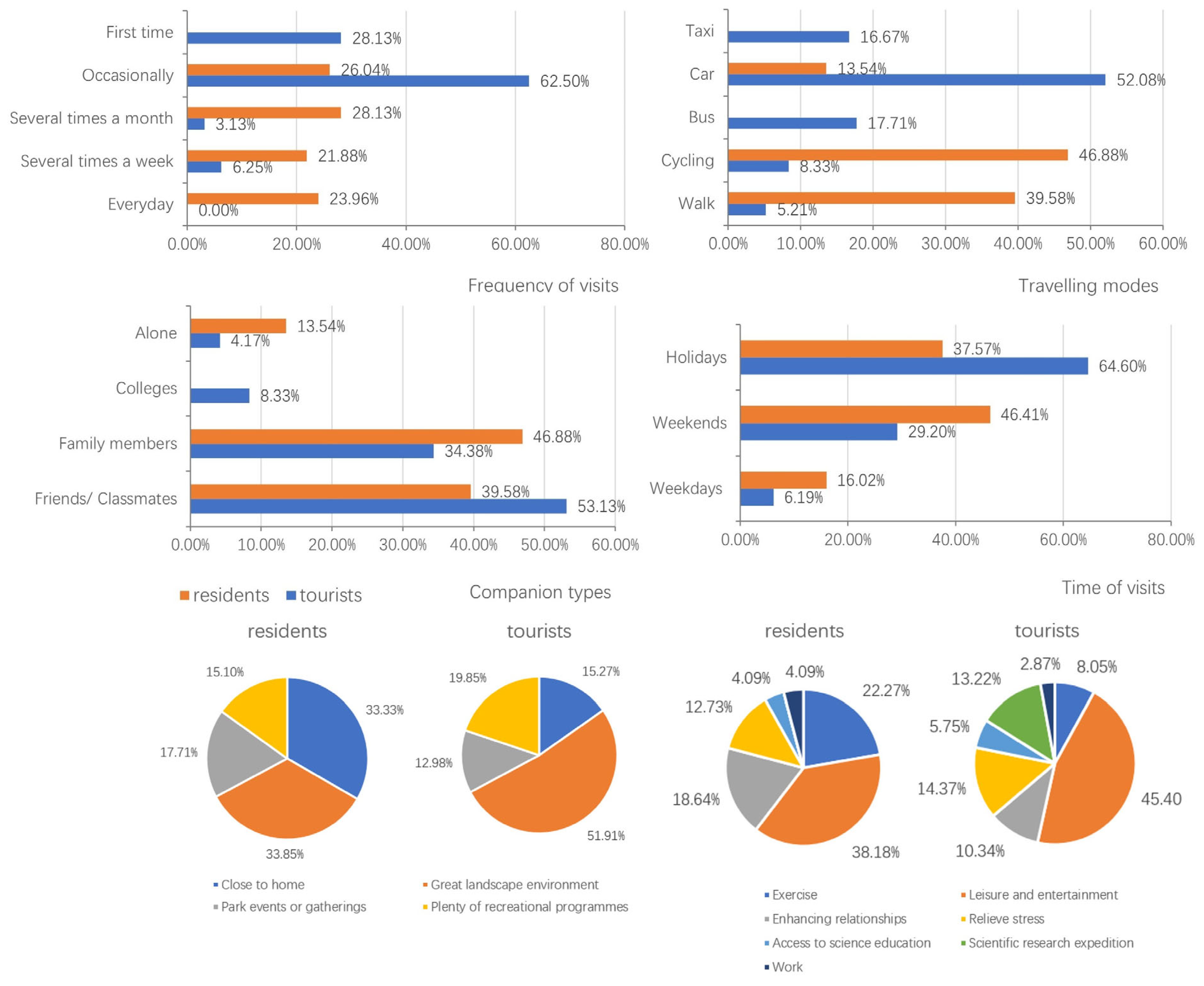

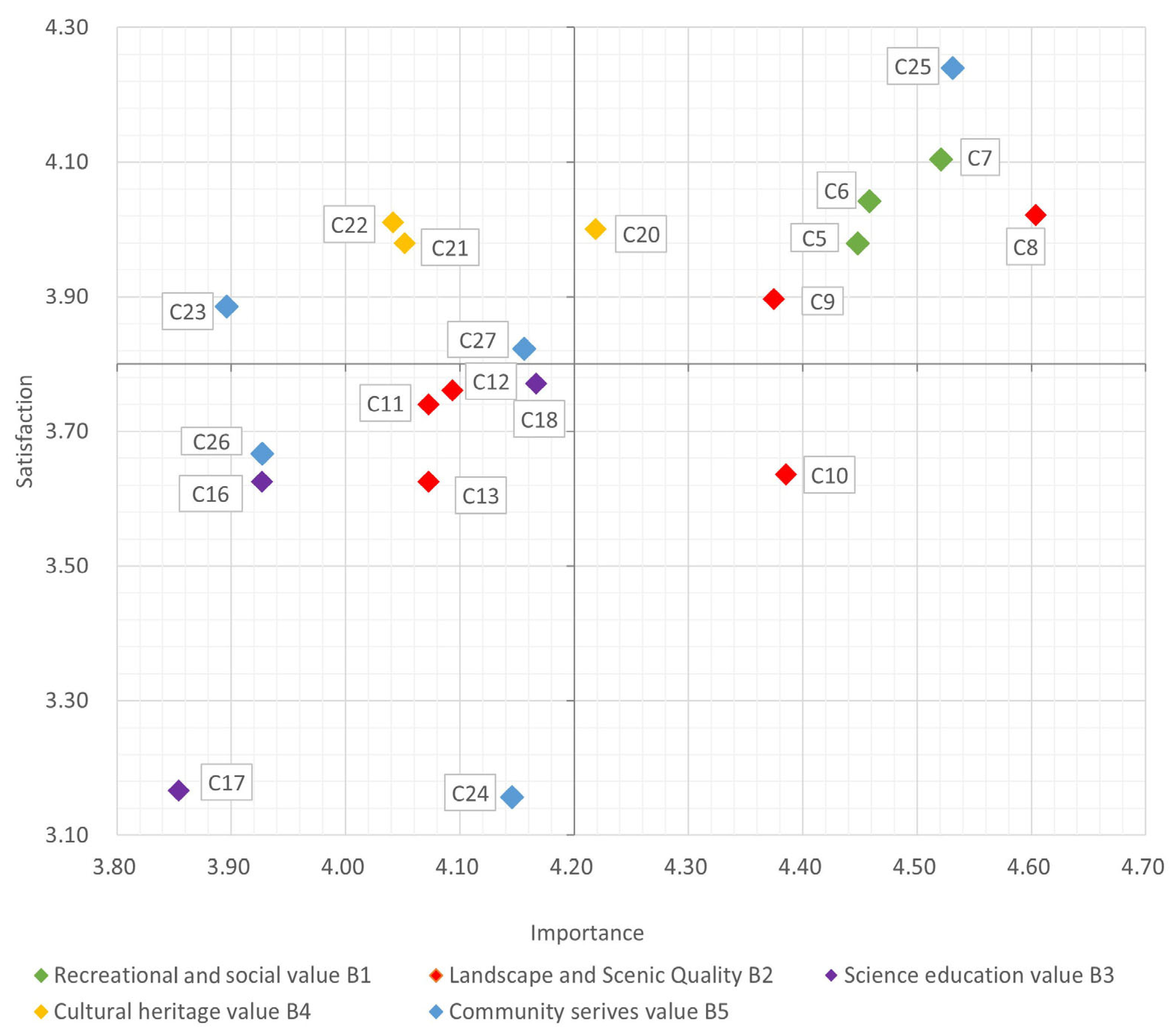
| Criterion Layer | Indicator Layer | Indicator Explanation | Data Source/Tool |
|---|---|---|---|
| Recreational and Social Value (B1) | Visitor Numbers (C1) | Total number of visitors received over a period after park construction | Visitor flow monitoring and statistics |
| Dwell Time (C2) | Hours visitors spend in the park | Questionnaire survey | |
| Visit Frequency (C3) | Frequency of visits to the park over a period | Questionnaire survey | |
| Planned/Organized Activities (C4) | Frequency of events such as festivals, concerts, and cultural activities | Interviews and departmental data statistics | |
| Accessibility (C5) | Layout of entrances and exits, convenience of public transport transfers | Questionnaire survey | |
| Tourist Route Convenience (C6) | Rationality of vehicle and pedestrian systems, parking facilities, and accessibility facilities | Questionnaire survey | |
| User Safety Experience (C7) | Expanded visibility, presence of security personnel, openness of the park | Questionnaire survey | |
| Landscape and Scenic Quality (B2) | Aesthetic Quality of Water Bodies (C8) | Area, color, and sediment of water bodies | Questionnaire survey |
| Aesthetic Quality of Shorelines (C9) | Types of shorelines (artificial, semi-artificial, natural) | Questionnaire survey | |
| Water Feature Diversity (C10) | Presence of ponds, open lake surfaces | Questionnaire survey | |
| Plant Diversity (C11) | Variety of aquatic and terrestrial plants (trees, shrubs, herbaceous plants) | Questionnaire survey | |
| Public Art Significance (C12) | Presence of landscape sculptures and unique features | Questionnaire survey | |
| Night Scene Quality (C13) | Number and distribution of streetlights, lighting effects | Questionnaire survey | |
| Educational Value (B3) | Frequency of Educational Activities (C14) | Frequency of activities such as nature education, gardening classes, and children’s science education | Interviews and departmental data statistics |
| Completeness of Educational Facilities (C15) | Richness and rational distribution of educational facilities such as science museums, signage systems, and observation stations | Interviews and departmental data statistics | |
| Completeness of Interpretive Systems (C16) | Prominence of interpretive signs for flora and fauna and ecological restoration techniques, detailed guided tours | Questionnaire survey | |
| Perceived Participation in Experiential Learning (C17) | Experiential learning through wetland museums, park celebrations, and understanding of subsidence and restoration processes | Questionnaire survey | |
| Perceived Effectiveness of Science Communication (C18) | Enhancing public awareness of ecological and environmental protection | Questionnaire survey | |
| Scientific Research and Achievements (C19) | Surveys and monitoring of hydrology, water quality, wetlands, and biodiversity | Interviews and departmental data statistics | |
| Cultural Heritage Value (B4) | City Image Shaping (C20) | Improvement of city image and promotion of local characteristics | Questionnaire survey |
| Historical Continuity (C21) | Recording the history of urban coal industry development and urban rise and fall | Questionnaire survey | |
| Promotion of Ecological Culture (C22) | Recording the ecological transformation of the city and reflecting the concept of “ Green Water and Green Mountains are Valuable Assets” | Questionnaire survey | |
| Community Service Value (B5) | Sense of Place (C23) | Users’ sense of identity and belonging to the park | Questionnaire survey |
| Increase in Community Residents’ Income (C24) | Perceived increase in income by surrounding residents | Questionnaire survey | |
| Improvement of Public Health (C25) | Alleviation of emotional stress, noise reduction, and enhancement of quality of life and visual experience | Questionnaire survey | |
| Enrichment of Community Cultural Life (C26) | Hosting community cultural and entertainment activities to promote neighborhood interaction | Questionnaire survey | |
| Improvement of Community Public Facilities (C27) | Renovation and design improvements to the community public environment after park construction | Questionnaire survey | |
| Disaster Prevention and Mitigation (C28) | Effective disaster avoidance area, population capacity, and sufficiency of disaster prevention facilities for emergency rescue | Questionnaire survey |
| Level | SLP Value | Characteristics |
|---|---|---|
| Very poor | 0 < Xi ≤ 1 | The social landscape performance of the park is very poor. None of the social values are reflected. The park fails to deliver recreational and social value, as well as landscape and scenic quality. It is unable to meet the social service needs of the surrounding residents. |
| Poor | 1 < Xi ≤ 2 | The social landscape performance of the park is poor. All the social value is not well presented. The park needs to pay extra attention to recreational and social value and improve the landscape and scenic quality. The community services barely meet residents’ needs very well. |
| Fair | 2 < Xi ≤ 3 | The social landscape performance of the park is average. The recreational and social values, as well as the landscape and scenic quality, are ordinary. The cultural characteristics are not prominent, and both the educational value and social service value require attention and have space for improvement. The community services basically meet residents’ needs. |
| Good | 3 < Xi≤ 4 | The social landscape performance of the park is in a relatively good state. The park offers recreational and social values and has distinct cultural characteristics. It also has good landscape quality and educational facilities. Residents around the park can gain certain social benefits from it. |
| Excellent | 4 < Xi ≤ 5 | The social landscape performance is in an excellent state. Visitors can enjoy recreational and social values as well as cultural characteristics. The park boasts high-quality landscapes and a comprehensive science popularization and education system. Additionally, residents surrounding the park can gain social benefits from it. |
| Variables | Demographic Characteristics | Frequency | Ratios | Variables | Demographic Characteristics | Frequency | Ratios |
|---|---|---|---|---|---|---|---|
| Gender | Male | 93 | 48.44% | Employment | Students | 39 | 20.31% |
| Female | 99 | 51.56% | Employees of enterprises and institutions | 41 | 21.35% | ||
| Staff of institutional units | 10 | 5.21% | |||||
| Age | Under 18 | 10 | 5.21% | Commercial, service industry employees | 11 | 5.73% | |
| 18–30 | 68 | 35.42% | Private business owners, individual Entrepreneurs | 12 | 6.25% | ||
| 31–45 | 41 | 21.35% | Workers | 20 | 10.42% | ||
| 46–60 | 44 | 22.92% | Freelancers | 25 | 13.02% | ||
| 60 and above | 29 | 15.10% | Retirees | 34 | 17.71% | ||
| Education | Middle school or below | 61 | 31.77% | Income | <CNY 2000 | 79 | 41.15% |
| High school and technical | 40 | 20.83% | CNY 2000–5000 | 58 | 30.21% | ||
| CNY 5000–8000 | 36 | 18.75% | |||||
| College | 58 | 30.21% | CNY 8000–10,000 | 11 | 5.73% | ||
| Graduate and above | 33 | 17.19% | >CNY 10,000 | 8 | 4.17% |
| Criterion Layer | Weight | Indicator Layer | Weight |
|---|---|---|---|
| Recreational and Social Value (B1) | 0.271 | Visitor Numbers (C1) | 0.048 |
| Dwell Time (C2) | 0.048 | ||
| Visit Frequency (C3) | 0.031 | ||
| Planned/Organized Activities (C4) | 0.033 | ||
| Accessibility (C5) | 0.030 | ||
| Tourist Route Convenience (C6) | 0.031 | ||
| User Safety Experience (C7) | 0.050 | ||
| Landscape and Scenic Quality (B2) | 0.39 | Aesthetic Quality of Water Bodies (C8) | 0.082 |
| Aesthetic Quality of Shorelines (C9) | 0.063 | ||
| Water Feature Diversity (C10) | 0.089 | ||
| Plant Diversity (C11) | 0.064 | ||
| Public Art Significance (C12) | 0.029 | ||
| Night Scene Quality (C13) | 0.022 | ||
| Educational Value (B3) | 0.131 | Frequency of Educational Activities (C14) | 0.019 |
| Completeness of Educational Facilities (C15) | 0.036 | ||
| Completeness of Interpretive Systems (C16) | 0.024 | ||
| Perceived Participation in Experiential Learning (C17) | 0.011 | ||
| Perceived Effectiveness of Science Communication (C18) | 0.019 | ||
| Scientific Research and Achievements (C19) | 0.022 | ||
| Cultural Heritage Value (B4) | 0.138 | City Image Shaping (C20) | 0.051 |
| Historical Continuity (C21) | 0.032 | ||
| Promotion of Ecological Culture (C22) | 0.055 | ||
| Community Service Value (B5) | 0.113 | Sense of Place (C23) | 0.018 |
| Increase in Community Residents’ Income (C24) | 0.019 | ||
| Improvement of Public Health (C25) | 0.039 | ||
| Enrichment of Community Cultural Life (C26) | 0.013 | ||
| Improvement of Community Public Facilities (C27) | 0.014 | ||
| Disaster Prevention and Mitigation (C28) | 0.010 |
Disclaimer/Publisher’s Note: The statements, opinions and data contained in all publications are solely those of the individual author(s) and contributor(s) and not of MDPI and/or the editor(s). MDPI and/or the editor(s) disclaim responsibility for any injury to people or property resulting from any ideas, methods, instructions or products referred to in the content. |
© 2025 by the authors. Licensee MDPI, Basel, Switzerland. This article is an open access article distributed under the terms and conditions of the Creative Commons Attribution (CC BY) license (https://creativecommons.org/licenses/by/4.0/).
Share and Cite
Li, C.; Chang, J.; Feng, S.; Zhou, S. From a Coal Mining Area to a Wetland Park: How Is the Social Landscape Performance in Pan’an Lake National Wetland Park? Land 2025, 14, 1305. https://doi.org/10.3390/land14061305
Li C, Chang J, Feng S, Zhou S. From a Coal Mining Area to a Wetland Park: How Is the Social Landscape Performance in Pan’an Lake National Wetland Park? Land. 2025; 14(6):1305. https://doi.org/10.3390/land14061305
Chicago/Turabian StyleLi, Cankun, Jiang Chang, Shanshan Feng, and Shiyuan Zhou. 2025. "From a Coal Mining Area to a Wetland Park: How Is the Social Landscape Performance in Pan’an Lake National Wetland Park?" Land 14, no. 6: 1305. https://doi.org/10.3390/land14061305
APA StyleLi, C., Chang, J., Feng, S., & Zhou, S. (2025). From a Coal Mining Area to a Wetland Park: How Is the Social Landscape Performance in Pan’an Lake National Wetland Park? Land, 14(6), 1305. https://doi.org/10.3390/land14061305





